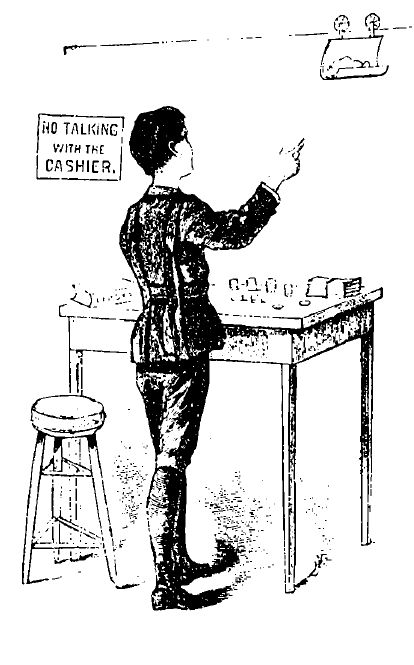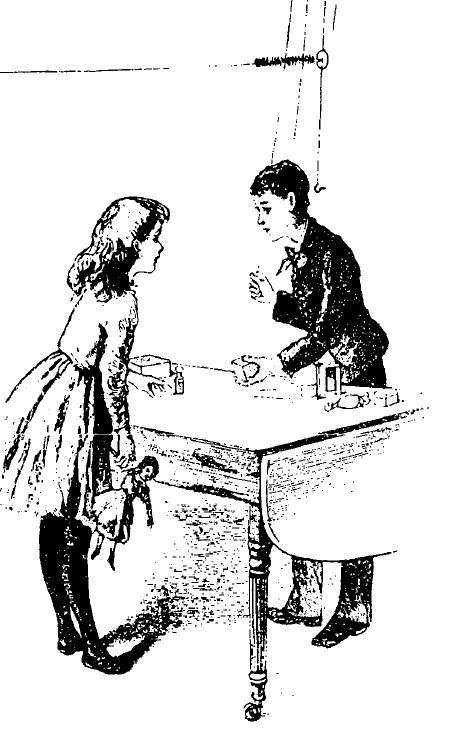

THE CASH RAILWAY WEBSITE |
||||||||
| Home | Manufacturers | Cash Balls | Wire systems | Cable systems | Pneumatic systems | Locations | References | Patents |
"In the new Technical High School at Omaha, Neb. ... Other features of the building include classes in salesmanship, where all the working parts of a department store are in use, even to the cash-carrier system of overhead wires and cages." Popular Mechanics, vol. 39, no.6, Jun. 1923, p.835
Many children (including me) tried to make their own cable cars or other overhead carriers, perhaps using Meccano. For example:
"Efforts to make a cash carrier to run over a wire track, like some we had seen in stores, likewise ended in failure." Howard E. Good. Black Swamp Farm. (Ohio State Univ. Press, 1997) p.155
"The overhead wires for sending your money to the cash office fascinated us children, and we used to replicate the system at home, using a length of string and one of those plastic balls for keeping your knitting wool in." Agenoria in Vocal Voices, 9/5/10
"Harwoods, one of the big clothing shops in Strood, had a splendid overhead wire cable-way for transporting containers of receipts and money back and forth between the counters and the cash-office. This inspired several model imitations, which moved objects around my bedroom!" Etherington in WW2 People's War archive
"By means of strings and pulley they developed a crude overhead device (a rough copy of one still in use in some stores) .. whereby the play money could be sent in a basket to the cashier's desk." BROWN, Corinne. Creative drama in the lower school (New York:Appleton, 1929) p.7
"A Christmas fair for local charity or for church purposes has ben successfully carried out under the name of a 'Department Store'... Two of the boys had rigged up a cash trolley, and one of the girls sat aloft in an improvised cashier's cage and made change for all the departments." Barre [VT] Daily Times, 20 Dec. 1912, p.8
There were also some commercial toys:


• The illustrations above are from an advertisement "The Young Storekeeper's Outfit" in The Youth's Companion, 31 Oct. 1889, p. 565. The kit contains "one Rapid Transit Cash Carrier", complete and ready to set up... A bright boy and girl will need no instruction as to the proper way to run a store".

• "See the children play Store with the trolley cash railway. A practical exhibition of this famous toy. Bring the children to see the fun. The greatest stormy day play ever invented. Teaches children to count and make change. A complete toy cash railway with play money. Just like those you see in the stores. Each outfit attached to 15 full feet of bright steel track wire, ready to hang up. 38c and 50c." Daily Morning Journal and Courier (New Haven CT), 6 Dec. 1902, p. 1
• "It's Christmas time in 1902 and the Bartholomew kids have received a Franklin Play Store set complete with toy money, products to sell and an overhead cash carrier." With illustration. Charles B. Townsend. The world's biggest puzzle book. (New York: Stirling, 2002), p.545.
• "Trolley cash railway, similar to what The Big Store uses. 40 [cents]". Advertisement by Siegel Cooper Co. of New York. Evening World, 19 Dec. 1902
• "Edwin Gould at Annapolis. One of the attractive toys for children is the trolley cash system. There are wires to stretch across a room, the cash carriers and a quantity of money of various denominations, and all for 50 cents." New York Times, 17 Apr. 1903
"Just a glance at the marvellous assembly of toys [at Macy's] ... Cash railways, • 44c." Evening World [New York] 30 Nov. 1903, p.4
• "Play Store, 25c. A cash trolley cash railway, and it is very practical. It has 15 feet of steel track wire and red money cups." (Advertisement for S. Kann, Sons & Co., 8th St. and Pa. Ave.) Evening Star [Washington DC], 17 Nov. 1905, p. 8
• "One can buy toy shops .. with all the up-to-date equipment in miniature, including cash railways and sale dockets ready printed." Belfast Telegraph, 7 Dec. 1936, p. 8
• "I found the one [present] that had come from Aunt Lulie in New York... Out came a cash carrier and basket for packages, exactly like the ones at Mr. Vatet's or Mr. McNaughton's store, with lines to string them up overhead. You could play store, put the pretend money in the little, round carrier, pull it up by a rope until it joined the crossway pulley with a little tinkle of a bell, exactly like the ones at the store, the basket with the packed parcels swinging underneath. At the other end, wherever you put the cashier, it would stop and she would take out the packages, wrap them up, take out the the pretend money, put back pretend change, and push it on its return trip... The cash and package carrier was, immediately, the neighborhood's favorite toy. That was what brought us indoors to play, even on week days. In my experience there had never been anything more exhilarating than to conduct a transaction over the ironing board placed between my doll's carriage and doll's bureau for a counter, put the cardboard money, which had come with the game, into the carrier, the parcel into the basket, pull the rope until they clicked with the ring of a bell, and then send them off all the way across the room, where Mitchell sat up on a chest of drawers and was the cashier." Emily Kimbrough. How dear to my heart (New York: Dodd, Mead, 1944), p.179